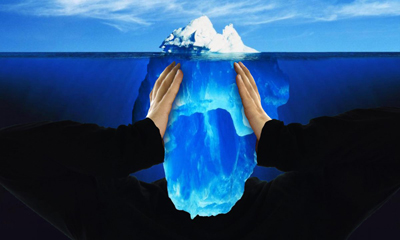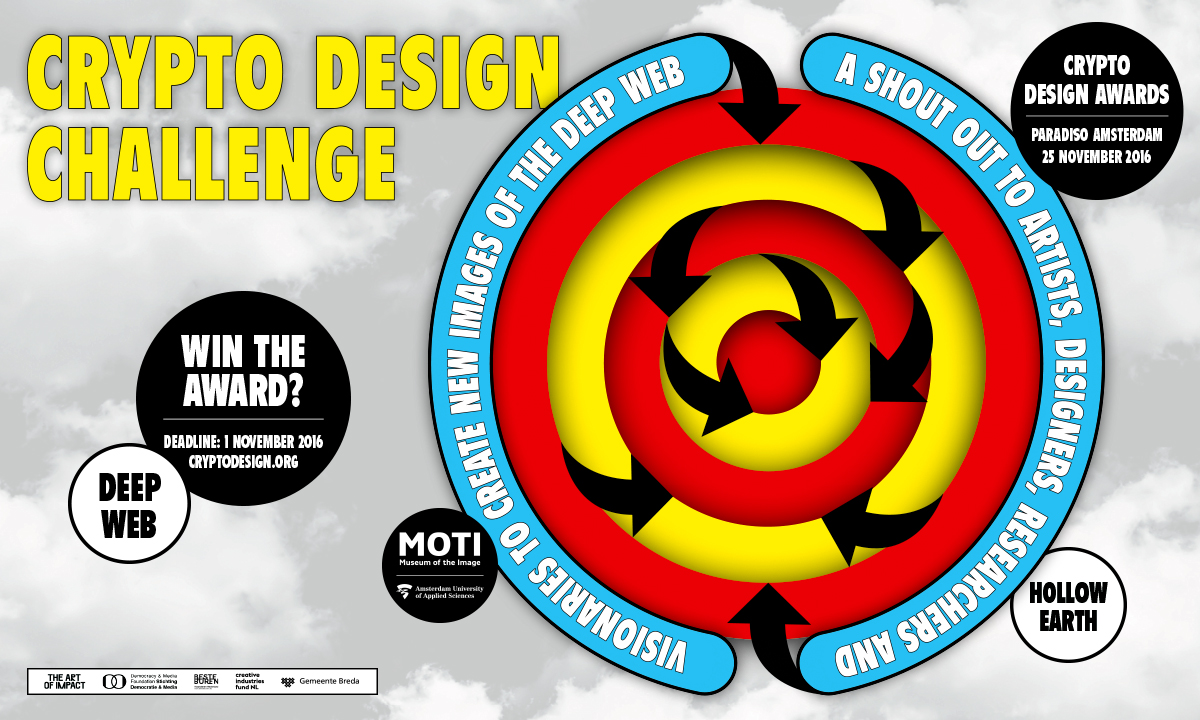Crypto Design Challenge
November 25, 2016 Paradiso

DEEP WEB!
The Deep Web evokes images of an underworld, the locus of shadow economies where illicit trade takes place that cannot bear the light of day. The Deep Web is much more than an online black market teeming with illegal activity. In fact, the Deep Web contains an estimated 96% of all the content to be found circulating online. It is one of the remaining bastions of individual privacy against corporate and governmental snooping and data mining, a place where anyone can remain anonymous.
The iceberg metaphor affects popular understanding of the Deep Web, as the inaccessible dangers of the murky “underwater” world. This Crypto Design Challenge is a shout out to artists, designers, researchers and visionaries to create a new images of the Deep Web.
Nowadays, we continually share data: a message via WhatsApp, a picture on Instagram, an update on Facebook or an e-mail via Gmail. How can you make sure that your personal data stay strictly personal?
The Crypto Design Challenge 2016 is an international open call to all designers and artists to develop new ideas and to submit inspiring plans and proposals to make the encryption of digital images and information accessible to all. Making texts and images secure is complicated, and it’s something that designers are not or insufficiently concerned about at present. This call aims to change that.
Speakers
Ingrid Burrington, Harry Halpin, Hendrik-Jan Grievink, Tijmen Schep, Stefan Schaefer, David Gauthier, Constant Dullaart, Moniker, Metahaven and others.
Schedule
| 11.00-13.00 | Performances and creative presentations given by designers and artists |
|---|---|
| 13.00-14.00 | Lunch and time to view artworks and submissions and also your opportunity to vote on one of the submissions |
| 14.00-16.00 | Speakers will dive in the Deep Web. Afterwards we announce the winner of the Audience Award and the Crypto Design Awards. |
Tickets
Tickets are €10 can be ordered here
Students can sign up here to get free tickets.
We will ask for your student card at the door.
A DEAD END?
The Deep Web evokes images of an underworld, the locus of shadow economies where illicit trade takes place that cannot bear the light of day. This image is understandable if you consider the bad press the encrypted channels have received over the years. News reporting mostly publishes sensational stories on cyber-criminals operating in a virtual legal vacuum on the Darknet, arms and human trafficking, murder-for-hire and extreme gore on contraband websites such as Silk Road. Data leaks, such as the Panama Papers, further politicized this so-called “invisible” web. Furthermore, the popular Deep Web documentary (2015) helped shape a dramatic image of these impenetrable parts of the Internet as a lawless cove, mainly populated by bandits, predators, and pirates.
The Deep Web is much more than an online black market teeming with illegal activity. In fact, the Deep Web contains an estimated 96% of all the content to be found circulating online. What defines this vast hidden depository is simply that it resides in encrypted databases and channels that cannot be indexed or accessed through search engines. Apart from crypto-currencies, porn and narcotics, this concealed territory contains a wide range of encrypted communication, academic and subscription-based journals, classified information, hidden wikis and onions, and much more that remains inaccessible when browsing and surfing the surface. This realm empowered many citizens during the Arab Spring, providing encrypted communication channels to coordinate protest. Indeed, it is an important communication tool for human rights NGOs, political dissidents, activists, and every other user who – for any reason whatsoever- wishes not to be tracked, stalked, and spied on. It is one of the remaining bastions of individual privacy against corporate and governmental snooping and data mining, a place where anyone can remain anonymous.
Three years after the Snowden revelations, we can safely conclude that the focus on surveillance and individual privacy has not lead to a thriving debate on the infrastructure, imagination and accessibility to information on the web.
It is difficult to fathom the implications of people’s bodies, purchases, chatter, random activities and affiliations constantly being collected, analysed, exploited and stored in a data-grid that is inaccessible and incomprehensible for most people. The privacy discourse has failed to spark the collective imagination — no matter how large and justified the outrage at leaking data and surveillance. Furthermore, the centralization of the internet’s infrastructure into a few data centers is going hand-in-hand with the content concentration of the Surface Web by five Tech Giants (the “Frightful 5”) and the encroaching “appification” of the Web. Daily web use is threatened by a lock-in web culture, uninhibited data mining, a stagnating debate on individual privacy, and an unaccessible and seemingly spammy Underworld Web. A dead end? Not necessarily.
SO YOU WANT TO BE A DEEP WEB DESIGNER?
The Internet is of often thought of in terms of naval metaphors. It a sea that can be surfed and navigated by search engines. Of course, metaphors are often meant to grasp something unfamiliar by comparing it to something familiar. One of the more dominant metaphors of the Deep Web is the iceberg. The top of the iceberg, above water, represents the Surface Web. The Surface Web contains all the data that can be “explored” by search engines like Google, Yahoo, Opera or Bing. Diving below the surface leads you into the nether regions of the Deep Web, with a vast amount of data that cannot be indexed by any of the popular search engines.
The iceberg metaphor affects popular understanding of the Deep Web, the “below water” part of the iceberg. As we all know, visual language, symbols and metaphors help us to describe, classify and understand the world around us; they are crutches for our mind. Images are often more powerful and influential than the things they represent, think of the cloud or the envelope and trash can icon in your (web) mail. Images are crucial vehicles of meaning making and production. In turn, the image of the iceberg gives shape to popular understandings of the Surface Web, and affects how the Deep Web comes to mind. For many, the Deep Web seems inaccessible to ordinary internet users—a members-only club of tech savvy geeks, hackers and fishy figures.
This Crypto Design Challenge is a shout out to artists, designers, researchers and visionaries to create a new images of the Deep Web. Have you ever sent an email through webmail? Have you ever paid your share of a dinner bill to a friend via online banking? Watched a movie on Netflix? Read an article on a password-protected website? Unwittingly, many of us use the Deep Web on a regular basis. Let us use our visual powers to plunge into deep waters and explore these parts of the web in order to resurface with a trove of imaginaries and metaphors. Let’s decrypt the ‘the deep’, enter its seemingly panic-room locked doors, explore its corridors, let light pour in and stale air escape. The aim of the first international crypto design challenge is to “go diving” into the Deep Web, to decrypt its content, and explore how these hidden infrastructures could be empowering, hospitable, and inspiring.
